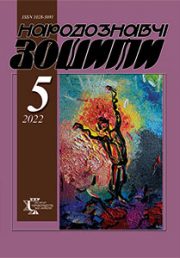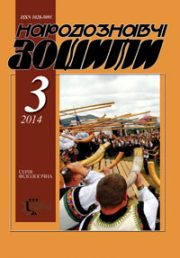The Ethnology Notebooks. 2022. № 1 (163), 65—79
UDK 745.52(=161.2):339.1″XX”
DOI https://doi.org/10.15407/nz2022.01.065
YAMBORKO Olha
- ORCID ID: https://orcid.org/0000-0003-0340-5436
- Сandidate of Аrts (Ph. D),
- Associate Professor of Design and Art Theory
- Vasyl Stefanyk Precarpathian National University,
- Str. Sakharova, 34-a, 76014, Ivano-Frankivsk, Ukraine,
- Contacts: e-mail: kalyna015@gmail.com
Abstract. Introduction. Handmade carpet industry in Ukraine in the late ХХ – early XXI century is on a new stage of development due to radical socio-economic changes, the need to adapt to market economy conditions. These changes led to a crisis of carpet weaving as a craft in Ukraine, which is associated with the collapse of the Soviet-style system of folk arts and crafts and the infrastructure of «Ukrhudozhprom» in particular. State programs for the revival of the folk arts and crafts and projects on carpet weaving have proved ineffective.The emergence of Ukrainian handmade carpet manufacturers on the national market can be argued since the late 2010s. This share is quite small, but is maintained as a phenomenon with a tendency to increase.
The relevance of the article is due to the need to form a modern strategy of handmade carpet industry in Ukraine.
The purpose of the article is to highlight the conditions of handmade carpet in Ukraine as an industry in the context of world practices.
The object of the article is Ukrainian handmade carpet as an industry, analogues of handicrafts industries in the world, and the subject is a set of current approaches from manufacturers, the state and non-governmental institutions, the international market as levers of modern development of handmade carpet weaving.
The paper uses historical and comparative research methods.
The source base is scientific literature, government decrees on folk arts and crafts, state and non-state programs and projects, publications in national and foreign media, websites of Ukrainian and foreign companies producing carpets and rugs.
Results.The article analyzes the state programs for the restoration of folk arts and crafts and projects on Ukrainian carpet weaving. Measures for the revival of carpet weaving as a craft in the countries of the Soviet past are highlighted and the practices of development of the handicraft industry among modern manufacturers – world market leaders are considered. A number of branded carpets in Ukraine, features of their products, management issues in today’s circumstances are outlined.
Conclusion. According to the study, we can conclude that state programs for the revival of the folk arts and crafts on carpet weaving have proved ineffective. Projects on modeling of the industry, the use of new forms of organization (Cluster «Suzir’ia») are not implemented in practice. Ukrainian hand-made carpet weaving began to appear on the national market in the late 2010s. To enter the European market, Ukrainian producers need quality raw materials and product certification, competent, cooperation of market participants and state support.
Keywords: Ukrainian handmadecarpet industry, handicraftcarpet market, infrastructure, development programs.
Received 11.01.2022
REFERENCES
- Mikula, N., & Datsko, O. (2010). Cluster of folk crafts in increasing the international competitiveness of the region. Mizhnarodna ekonomichna polityka (Issue 1—2, pp. 210—235) [in Ukrainian].
- (2006, june 6). Decree of the President of Ukraine. «On measures for the revival of traditional folk art and folk arts and crafts in Ukraine», 48. Retrieved from: http://zakon.rada.gov.ua/cgi-bin/laws/main.cgi?nreg=481%2F2006 (Last accessed: 04.10.2021) [in Ukrainian].
- Varyvonchyk, A. (2019). Reorganization of the industrial association «Ukrhudozhprom» and assignment of a trademark. Mystetstvoznavchi zapysky (Issue 35, pp. 137—144) [in Ukrainian].
- (2007, may 23). Resolution of Cabinet of Ministers of Ukraine. «State program for preservation, revival and development of folk arts and crafts for the period up to 2010», 768. Retrieved from: https://www.kmu.gov.ua/npas/80134506 (Last accessed: 01.10.2021 [in Ukrainian].
- (1994, january 26). Resolution of the Cabinet of Ministers of Ukraine. «On the state joint-stock company «Ukrhudozhprom», 28. Retrieved from: https://zakon.rada.gov.ua/laws/show/28-94-%D0%BF#Text (Last accessed: 04.10.2021) [in Ukrainian].
- (2018, february 22). Order of the State Property Fund. «On completion of privatization of PJSC «Ukrhudozhprom», 287. Retrieved from: http://search.ligazakon.ua/l_doc2.nsf/link1/FN0 40084.html (Last accessed: 25.09.2021) [in Ukrainian].
- (2004, december 7). Law of the Republic of Azerbaijan «On protection and development of Azerbaijan carpet art», 799-IIQ. Retrieved from: http://www.e-qanun.az/framework/7358 (Last accessed: 25.09.2021) [in Azerbaijani].
- State Program on protection and development of carpet art in the Republic of Azerbaijan for 2018—2022. Retrieved from: http://www.e-qanun.az/framework/38038 (Last accessed: 25.09.2021) [in Azerbaijani].
- Azerkhalcha. Retrieved from: https://azerxalca.az (Last accessed: 05.10.2021) [in Azerbaijani].
- Safarova, D. (2018, june 12). Azerbaijan is increasing the production of carpets, but at what cost? Retrieved from: https://russian.eurasianet.org/node/65276 (Last accessed: 03/04/2020) [in Russian].
- (2011). Mehmet Huseyin Bilgin, Ender Demir, Marco Chi Keung Lau, Chester Kin-Man To, Zhi-Ming Zhang. The Turkish handmade carpet industry: an analysis in comparison with select Asian countries. The Journal of The Textile Institute, 6. (Vol. 102, pp. 514—526).
- Iran Carpet Company. Retrieved from: https://en.irancarpet.ir/ (Last accessed: 11.03.2020).
- Carpet Export Promotion Council India. Retrieved from: http://cepc.co.in/about-us?cepc-profile (Last accessed: 30.03.2020).
- State Bank of Pakistan. Research Report on ‘Handmade Carpet Manufacturing’ Segment. Retrieved from: https://www.sbp.org.pk/departments/ihfd/Sub-egment%20Booklets/Handmade%20Carpet%20 Manufacturing.pdf (Last accessed: 05.10.2021).
- (2016). Sayed Nasrad, Abdul Tamim Karimi The Afghan Carpet Industry: Issues and Challenges. Economics Alternatives (Issue 4, pp. 475—490).
- DOMOTEX. Retrieved from: https://www.domotex.de/en/about-us/about-domotex/ (Last accessed: 11.01.2021).
- DOMOTEX: Categories 2021. Retrieved from: https://www.domotex.de/en/side-events/awards/ carpet-design-awards (Last accessed: 11.01.2021).
- «Turkmenhaly» State Association. Retrieved from: https://www.turkmenhali.gov.tm/about. php ?about= 35b10 554b84dad2dfc18d9fae98e0643 (Last accessed: 05.10.2021) [in Turkmen].
- Public Association Fund for the Development of Carpet Production «Kyrgyz Kilem». Retrieved from: https://kyrgyzkilem.kg/o-fonde/ (Last accessed: 5.02.2021) [in Russian].
- (2006, july 15). Order of the Cabinet of Ministers of Ukraine «On approval of the Concept of the State program of preservation, revival and development of folk arts and crafts for 2006—2010», 336-р. Retrieved from: http://lawua.info/index.htm (Last accessed: 28.09.2021) [in Ukrainian].
- (2016). Folk arts and crafts of Ukraine: history, present, prospects: Scientific collection on the materials of the All-Ukrainian scientific-practical conference. Kyiv [in Ukrainian].
- (2010, january 27). Order of the Cabinet of Ministers of Ukraine «On the implementation of the cluster model of development of folk arts and crafts», 145-r. Retrieved from: https://zakon.rada.gov.ua/laws/show/145-2010-%D1%80#Text (Last accessed: 05.10. 2021) [in Ukrainian].
- Tkachuk, I.H., Kropel’nyts’ka, S.O, & Petruniak, A.D. (2009). Cluster of folk arts and crafts «Suzir’ia»: methods, commentary, advice. Ivano-Frankivsk [in Ukrainian].
- Registration card of the program and project «Implementation of the cluster model of development of folk arts and crafts in Prykarpattia». Retrieved from: http://dfrr.minregion.gov.ua/Project-annotation-full?PROJT=3652 (Last accessed: 25.02. 2021) [in Ukrainian].
- Lizhnyk. Retrieved from: https://www.facebook.com/Bogdanka1108 (Last accessed: 7.03.2021) [in Ukrainian].
- Gushka. Retrieved from: https://shop.gushka.com.ua/uk-ua/ (Last accessed: 7.03.2021) [in Ukrainian].
- Fajnyj lizhnyk. Retrieved from: https://www.facebook.com/100109195048539 (Last accessed: 7.03.2021) [in Ukrainian].
- Vandra Rugs. Retrieved from: https://vandra-rugs.com/ (Last accessed: 7.03.2021) [in Ukrainian].
- Zv’yazani. Retrieved from: https://zvyazani.com.ua/ (Last accessed: 7.03.2021) [in Ukrainian].
- Danylovs’ka, Ye. (2020, january 31). Founders of Zv’yazani: «People do not perceive that you have to pay for Ukrainian carpets». S’ohodni: Life. Retrieved from: https://lifestyle.segodnya.ua/ua/lifestyle/style/ osnovatelnicy-brenda-zv-yazani-lyudi-ne-vosprinimayut-to-chto-za-ukrainskie-kovry-nuzhno-platit-1395296.html (Last accessed: 8.03.2021) [in Ukrainian].
- Alexandrov & Partners (2016). Export algorithm: what a Ukrainian exporter needs to know. Retrieved from: http://loga.gov.ua/sites/default/files/collections/kniga-algoritm-eksportu.pdf (Last accessed: 06.09.2021) [in Ukrainian].
- (2017, december 29). Order DP «UkrNDNTs» «On the abolition of national regulations», 500. Retrieved from: http://uas.org.ua/ua/services/standartizatsiya/nakazi-dp-ukrndnts/2017-2/gruden/ (Last accessed: 06.09. 2021) [in Ukrainian].
- (2021, march 21). Artist Oksana Levchenia — about fashion for carpets and ecological production. Vogue UA. Retrieved from: https://vogue.ua/ua/article/culture/lifestyle/hudozhnica-oksana-levchenya-o-kovrah-ekologichnom-proizvodstve-i-predmetnom-dizayne.html (Last accessed: 26.04.2021) [in Ukrainian].
- (2019, april 16). Oksana Levcheni’s carpets will represent Ukraine at the Paris Biennale. Retrieved from: https://olk-manufactory.com/blogs/news (Last accessed: 26.04. 2021) [in Ukrainian].
- Solomia — Reshetylivka factory of arts and crafts. Retrieved from: https://reshfabrika.com.ua/ (Last accessed: 01.10.2021) [in Ukrainian].
- (2018, february 12). Order of the Ministry of Culture of Ukraine «On approval of the National list of elements of intangible cultural heritage of Ukraine», 105. Retrieved from: https://zakon.rada.gov.ua/rada/show/v0105734-18#Text (Last accessed: 01.10.2021) [in Ukrainian].
- Browse the Lists of Intangible Cultural Heritage and the Register of good safeguarding practices. Retrieved from: https://ich.unesco.org/en/lists?term[]=vocabulary_thesaurus-6286 (Last accessed: 01.10.2021) [in Ukrainian].






